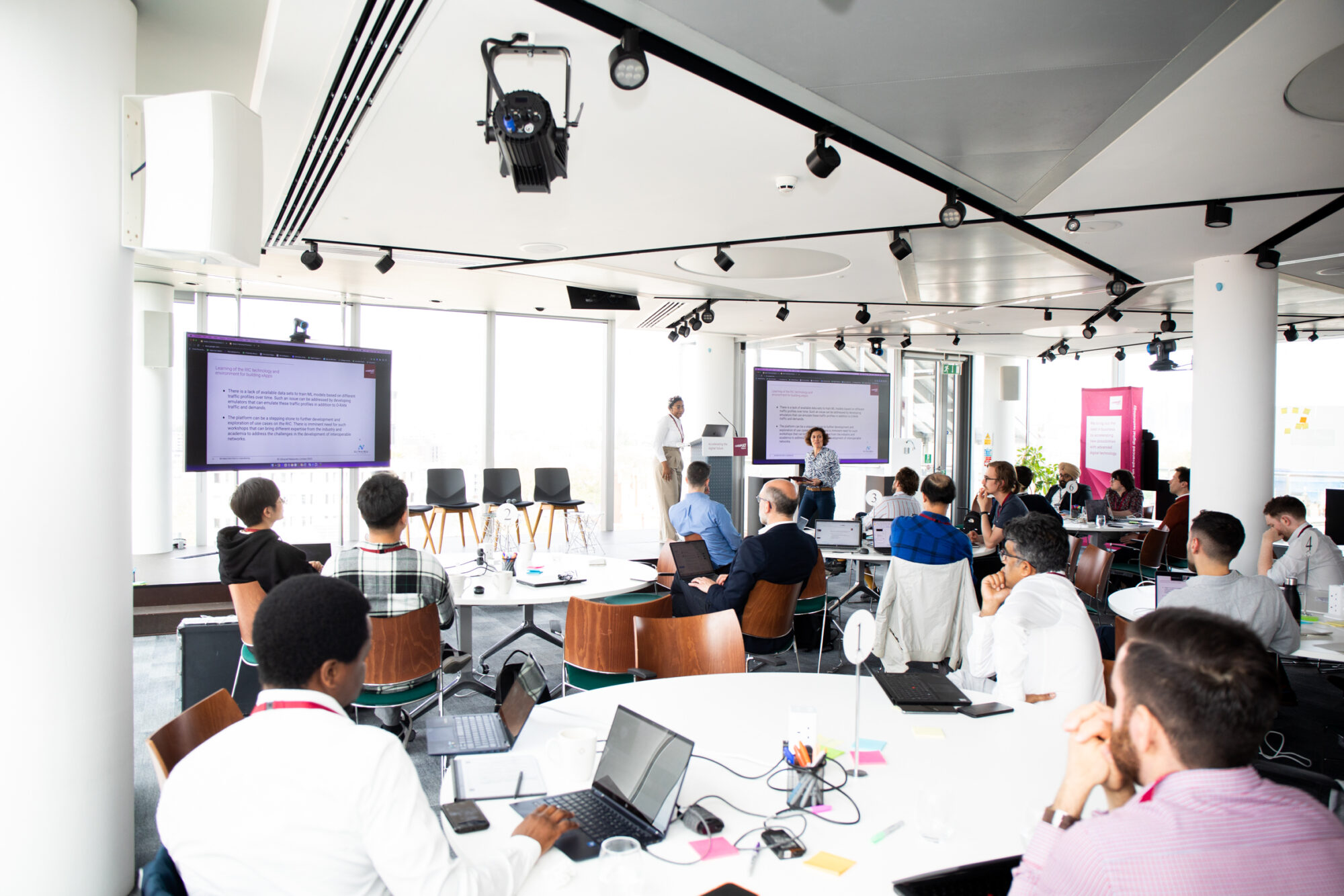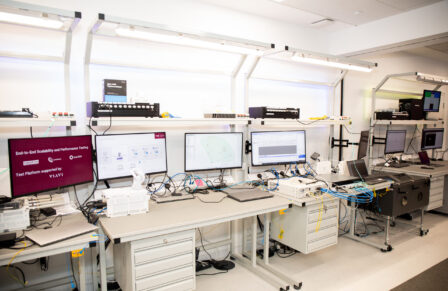Exploring the potential of Open RAN to address network energy efficiency
Posted 26 Jun 2023
Exploring the potential of Open RAN to address network energy efficiency
Linda Ligios, Senior Innovation Partner and Team Lead at Digital Catapult
In my previous blog, I discussed how Open RAN provides a platform to realise new innovation opportunities. For example, within our SONIC Labs programme we’re exploring how the real innovative potential of Open RAN sits in the RAN Intelligent Controller (RIC), a concept developed by O-RAN Alliance and built on principles of automation, Artificial Intelligence (AI) and Machine Learning (ML).
At Digital Catapult, working in partnership with Ofcom and supported by the Department for Science, Innovation and Technology (DSIT), we’re pioneering new early stage solution ideation activities to create an innovation layer of companies that can take advantage of Open RAN as an opportunity, whilst addressing supply chain diversification.
The Challenge
A couple of months ago, we set a challenge building on our previous work to validate RIC applications focused on energy efficiency and support innovators to develop new and existing ideas. One of the key features of the RAN Intelligent Controller (RIC) is to support and optimise quality of service and coverage, the way it operates has a direct impact on energy usage.
Energy consumption constitutes between twenty and forty percent of network OPEX, the majority of which is consumed by the RAN and power amplifiers. With the increase of traffic demand and rising pressure from national governments to reduce greenhouse gas (GHG) emissions, it is becoming more imperative for the telecoms industry to find innovative ways to reduce energy use.
For this challenge, we worked in partnership with Vodafone and Accelleran. The two companies were looking for a solution that takes into account the dynamic nature of a 5G network by analysing the Quality of Service (QoS) parameters and optimising the energy consumption of the RAN.
Open RAN RIC technology and machine learning algorithms can be used to monitor and analyse QoS parameter values for each user and application. The QoS parameter can be used to determine the signal strength and quality of the radio link between a user device and a base station. Participants were given access to Accelleran’s Software Development Kit (SDK) and tasked with exploring how xApp third-party applications running on the Open RAN RIC from Accelleran could help to optimise energy usage.
Introducing the innovators
Software developers and AI experts from both SMEs and academia responded to the challenge and applied their knowledge and experience from within and outside the telecom domain. Participants were offered two online educational sessions ahead of an in-person innovation ‘Ideate’ Workshop in mid May 2023 to help them get up to speed with the fundamentals of RIC technology and innovation opportunities in the area of RAN energy efficiency.
The participating organisations included: B-Yond, Chilton Computing, Flying River, King’s College London, Net AI, University of York, Ultracell Networks and Zizo.
The innovators approached the challenge in creative ways and developed early-stage solutions in a simulated RIC environment. The solution development approaches included external sensor data integration, neural modal training and customisation, Cluster and Virtual Machine (VM) placement for process steering, and deep deterministic policy gradient algorithms as a deep learning method.
The workshop offered SMEs and academia a unique opportunity to share knowledge, build new relationships and potentially explore new partnerships with other SMEs, academics and big players like Vodafone and Accelleran. It was also inspiring to see the enthusiasm of participants as they pitched their approach to solving the challenge.
The event also included a panel discussion with Arnaud Polster, CSO at Accelleran, and Fawad Hasan, Senior Open RAN Engineer at Vodafone, about readiness of the Open RAN infrastructure, other RIC use cases and innovation potential of AI/ML for network optimisation.
Hear from our partners and participants
By harnessing the capabilities of Accelleran RAN Intelligent Controller (RIC) and the transformative potential of Machine Learning, we are setting the stage for unprecedented advancements in RAN automation, intelligence and optimisation. Accelleran’s mission, inherently aligned with Open RAN, seeks to collaborate with innovation partners who are using Accelleran’s RIC SDK to create xApps and rApps that redefine RAN efficiency and sustainability, as successfully demonstrated during the recent event with Energy Optimisation. Arnaud Polster
CSO at Accelleran, whose RAN Intelligent Controller (RIC) platform and xApp/rApp SDK were used in the challenge
Vodafone is delighted to collaborate in the ‘Ideate’ Workshop by bringing our experience from multiple trials and live deployments to share our in-depth understanding on how Open RAN can act as a catalyst for network innovation and the evolution of the telecommunications industry. Energy efficiency in Open RAN networks is key to reducing mobile network operator total cost of ownership, as well as introducing a new way of delivering digital services. Improving the energy efficiency of our network partly relies on taking advantage of openness, flexibility and innovation of Open RAN. We believe Energy Efficiency for Open RAN networks should therefore hinge on the following domains:
– In the Hardware Domain, with particular focus on radio transmitters and cloud infrastructure. As an example, O-RUs represent the major part of the overall power consumption in RAN, and they require more efficient Power Amplifiers and the ability to switch off most of the transmitter elements and digital front-end when the network is unloaded.
– In the Software Domain, a range of features to be supported in order to deactivate network elements at low load in a dynamic manner.
– In the Artificial Intelligence and Machine Learning Domain, these technologies provide the means to simultaneously achieve energy reduction objectives while optimizing user experience.
– Finally, RIC and their associated rApps, and xApps constitute the ideal enabler to orchestrate aforementioned domains and to pave the way for energy efficient networks happen. Dan Shannon
Technical Specialist at Vodafone, a partner on the project
The RIC can play a vital role in growing the open networks ecosystem which will increase diversity and resilience in our critical national infrastructure. DSIT is funding numerous projects to develop automation and intelligence in the RAN so seeing that brought to life by the teams involved was a pleasure. Tom Rumbelow
Head of Open RAN Policy and R&D at DSIT
It was great to learn the Open RAN and RIC skills that our team doesn’t have, and to have the opportunity to work with other companies with distinctly more AI/ML knowledge that we can assist with our strong data background. Marco Germanier
Data Consultant at Zizo, a participating company in the challenge
We are confident that there is clear potential and capability out there to use AI/ML, Open RAN and RIC to optimise energy efficiency for networks following this challenge. Erica Yang
Managing Director at Chilton Computing, a participating company in the challenge
Key takeaways
Following the challenge we gathered a number of key insights we’ll be exploring further:
- We learnt that telecom and Open RAN specific concepts are not a barrier for innovators who have AI/ML expertise but are new to Open RAN and there is interest to develop new intelligent applications for network optimisation.
- We now understand that innovators are interested in exploring RIC technology and developing intelligent applications – but connecting with the relevant stakeholders in the ecosystem and being able to access resources and open Application programming Interfaces (APIs) are often a barrier. Experimental activities such as those delivered by SONIC Labs can enable access to SDK platforms that would not otherwise be possible, due to prohibitive costs and resources.
- There are great opportunities for SMEs and academia to leverage their AI/ML expertise for the development of other solutions for RAN Software Automation.
- There is an opportunity for SONIC Labs to further support the development of xApps solution in a real-scenario providing access to data sets to enable training of AI/ML models.
Next steps
With these experimental activities we have proved that the RIC is a great opportunity for innovators, and we are putting together plans to support SMEs and academia further to develop new and existing ideas focusing on more open, flexible and effective software based components.
These activities have allowed us to validate an innovation methodology that we can apply to other Open RAN areas where software innovation could be enabled, for example leveraging standards DevOps to support Open RAN lifecycle management and ensure ‘Continuous Integration and Continuous Deployment’ (CI/CD) of components from different vendors.
We are currently exploring further opportunities to unlock innovation in Open RAN. If you have any ideas please reach out to our innovation team at: [email protected]
I would like to thank our key partners, both Accelleran and Vodafone, for their time investment, expertise and support in bringing this challenge to life. Through their in-kind contribution we were able to accelerate the opportunity to unlock innovation in a relatively new space helping us to support new entrants to take advantage of Open RAN as an opportunity whilst addressing supply chain diversification.





